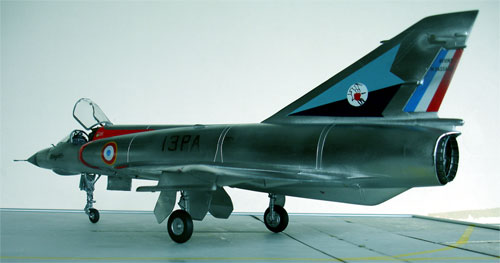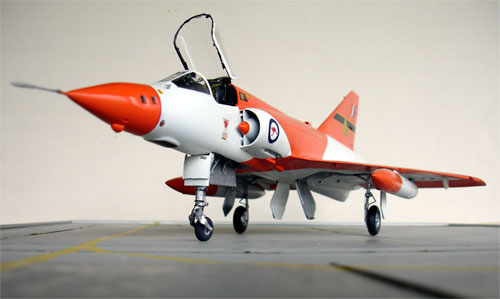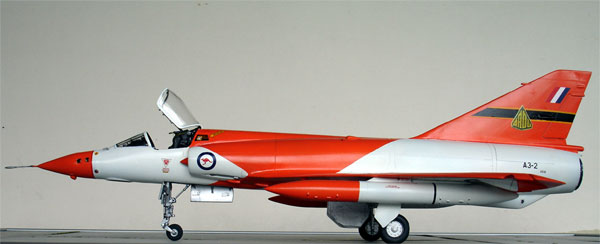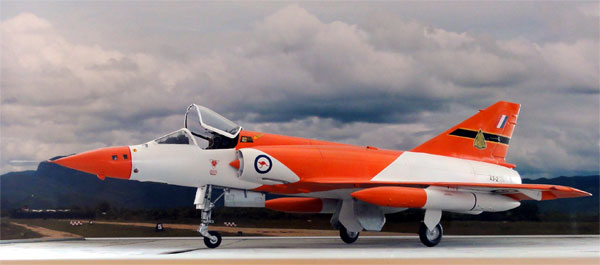[ Page 2 ]
Dassault Mirage III models in 1/32 scale
Mirage III Model [2] would be made in "traditional" old style French markings. The red intake markings were used as provided by the excellent Revell decals.
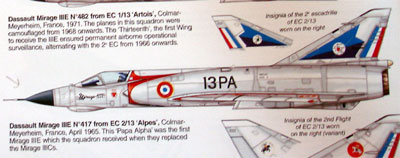
The EC 2/13 ALPES scheme as shown in the book of Breffort & Jouineau was selected as it has a nice colour scheme and tail markings. This meant that a number of kit decals could be used, but also I had to make the "Alpes" markings. This was done with a combination of coloured sheet, white Bare Metal decalsheet for the inktjet printer; After printing and drying, the decals were given a coat of special Microscale Decal Film to protect them. For the Escadre unit markings various decals were retrieved from the decal spares box and trim coloured decalsheet used from Xtradecal.
The overall model had obtained several
coats of the ALCLAD II and this is very gloss after polishing it with a
piece of cloth. Take care to avoid fingerprints, so handle the model at
the dark nose cone and rear tail pipe only.
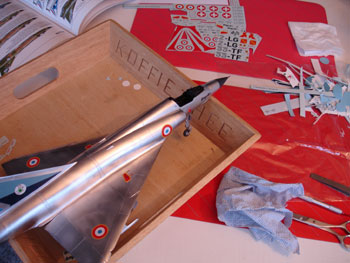
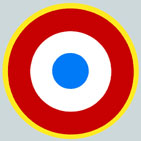
Decalling in progress....
The decals came mainly from the Revell
kit. I always apply a bit of JOHNSON FUTURE
(later called PLEDGE) on the back of the decal after it is removed from
its backing paper, and apply than; this will prevent silvering.
 ..
..
Details of the nose and main gear
seen above. With pieces of card and stretched sprue, details were added
such as braking wires, actuators and also the anti-swivel braces were made
from some card. The tyres needed a bit of putty and sanding but are otherwise
OK.
Tyres were painted "tyre black", hubs
metallic. Some washing done with a mix of Johnson FUTURE and black acrylic
paint, this provided some depth on the legs and bays.
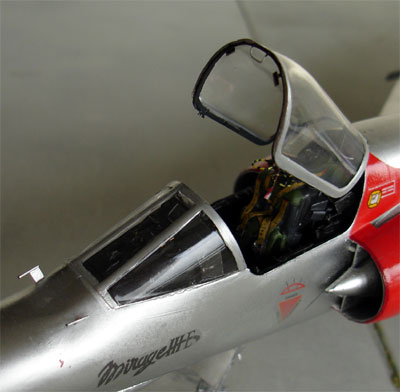
The canopy looked OK at first but
was not very clear (mould errors inside the plastic). There is not much
that can be done about this: I dipped the whole canopy into FUTURE
and carefully let the canopy dry.
The canopy got a couple of mirrors
and a handle cut from spare thin etched metal.
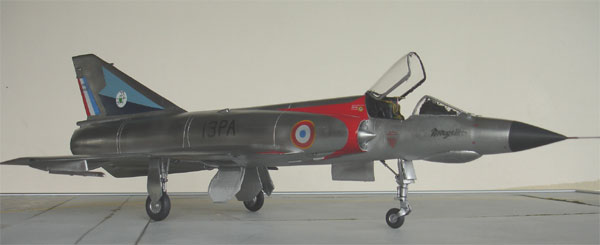

Also the Alpes squadron unit markings
on the tail can be seen.
Upper view. After applying the stencilling
and roundels (mostly from the kit), these were given a light "overspray"
of ALCLAD metallic aluminium (same colour as the overall colour). This
gives a very convincing effect.
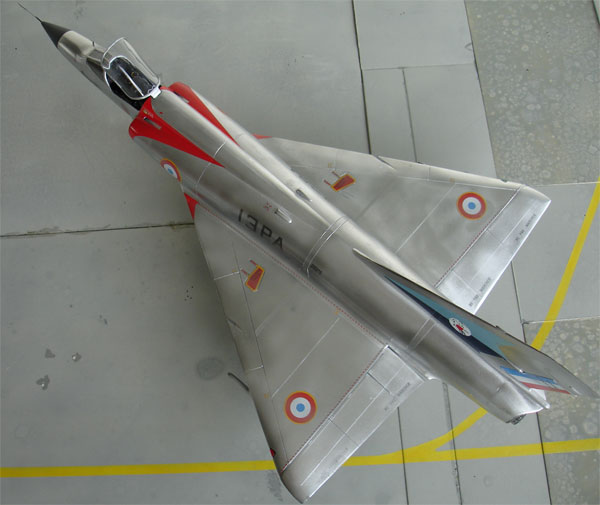
The flap edges were given a bit of
a darker wash with acrylic. The navigation lights as supplied in the kit
need some extra work as they do not fit well. Use a fine file and a bit
of Micro Kristal Klear to get a better flush fit and Tamiya transparant
colours.
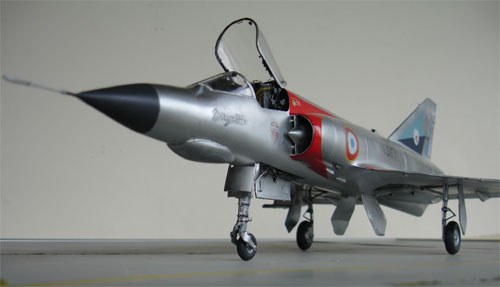
The ALCLAD II metallics were polished
for a last time with a piece of cloth. Than the overall model got
a light coat of FUTURE to protect shine
and decals.
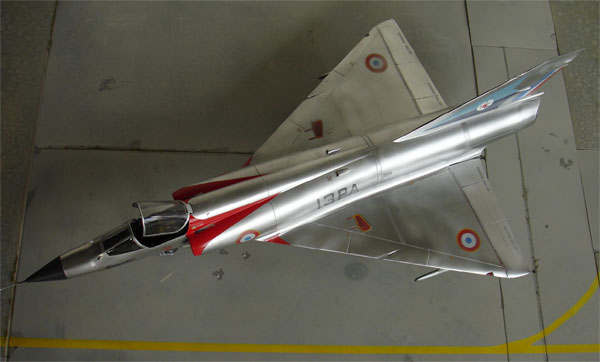
The pitot tubes came as last items.
The nose pitot tube has a particular shape on the Mirage III. I used the
front end of the kit part but also a piece of metal rod to get a better
appearance. The two small pitot tubes (although in the kit) in front
of the wind screen were made from a piece of card and rod.
As I had no good missiles in this
scale, these were not (yet) fitted on the model.
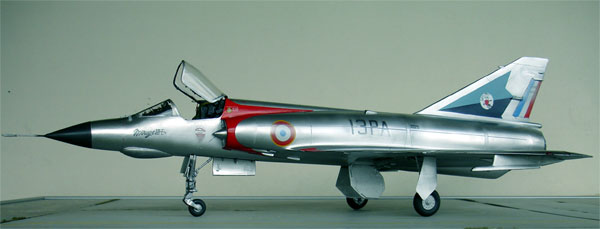
![]()
The Mirage III
of the "Alpes" ... a nice result I think.
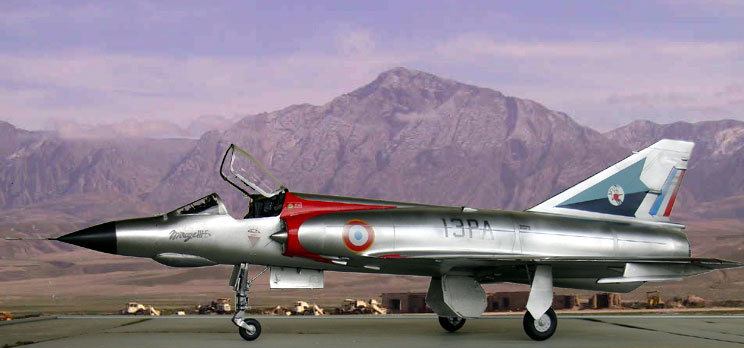
French AF of
EC 2/13 ALPES as based on Colmar in 1965... Note the alps mountains in
the background. Just joking.. this is the model
Model [1] of the Australian Mirage III O of the ARDU meant that a number of kit decals could be used, but the ARDU tail markings had to be made myself.

The scheme is seen in the book of Breffort & Jouineau drawings (although it has some small errors). With a search with Google on the internet you will find real photos of the ARDU planes.
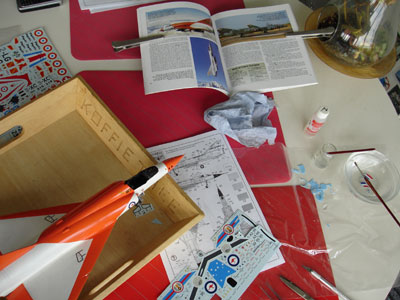
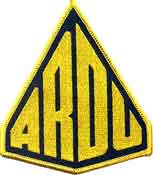
The ARDU symbol was also found on
the internet; it was scaled in the photo editor program to the correct
size in 1/32 and 4 copies printed on white decal sheet for inktjet printers
from Bare Metal foil.
After printing and drying, the decals
were given a coat of Microscale Decal Film to protect them. I used 2 copies
for each side over eachother after applying the black and yellow striping
in the tail.
[ NOTE DECEMBER
10, 2006: Flying High Decals released the ARDU decals
in their set: - RAAF Mirages Parts 1-9
;
Obviously I
already had finished my model... ]
Some decals such as the serials were
found in the spare decal box.
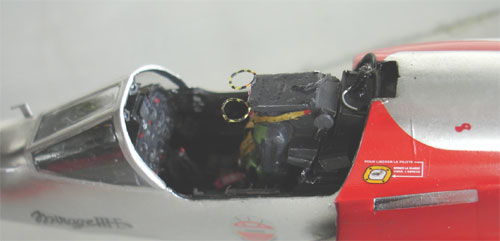
The resin seat of High Planes is
seen installed here. The seat got green and blue cushions and para packs,
the straps a mix of brown and grey. Seat buckles came from an etched metal
set and the seat got a black wash.
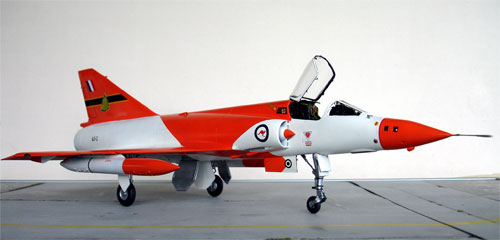
The overall plane of the ARDU is
in reality obviously kept in very good condition and has almost no weathering.
Only the flap panels and gear legs got a little black wash.
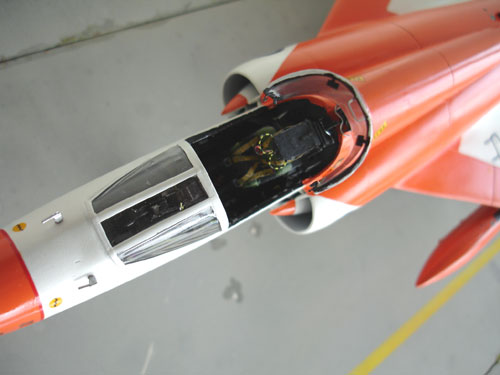
Note the rear panel with emergency
rescue arrow and panel. It was drilled open, painted and got a little Micro
kristal clear. The opened up camera windows in the nose were closed using
Microscale Kristal Clear as well. They got a protective coat of Future
after drying.

Here you can see the instrument cover
panel and seat. The canopy was hinged by using very tiny metal rods that
keep it into position. A small hole was drilled in the fuselage spine and
the model canopy is transportable.

The nose gear also got some details,
similar as the other Mirage III model.
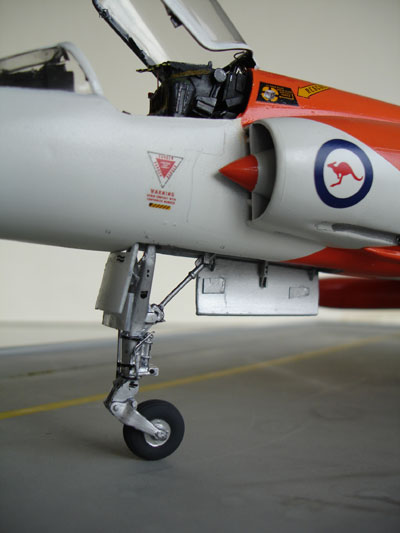
also note the
added detail onto the insides of the nose gear door.
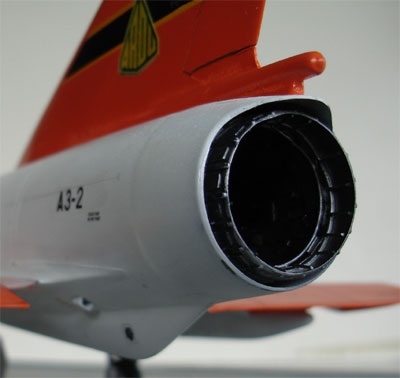
Here you will see some extra work
done on the tailpipe with metal rod and thin pieces of plastic. The whole
was given a metal look.
![]()
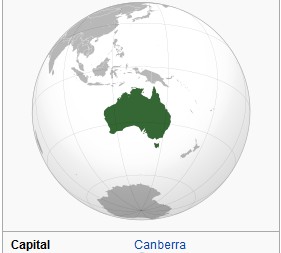


[ area: 7,700,000 km2 | population: 26 million | capital: Canberra | GDP per capita nominal 68,000 USD ]
In the British Commonwealth in Australia the Australian Flying Corps (AFC) was set up in 1912 with at Point Cook Victoria a flying school. The AFC was involved in the First World War with detachments to the RFC in Mesopotamia (Iraq), Egypt and England flying aircraft like the SE.5. Later, in 1921 the Royal Australian Air Force (RAAF) was established. Some of the types flown were Bulldogs, Demon fighters and Ansons. In 1936 the Commonwealth Aircraft Corporation (CAC) was set up and manufactured many aircraft in license like the Wirraway. During the Second World War Australia offered training to air crews under the Empire Air Training Scheme. After the bombing by Japan of Darwin in 1943, during the war many missions were flown using types like the Buffalo, Hudson and P-40s. The first Australian fighter, the Boomerang was produced by CAC along with Mosquitos and Beaufighters. A number of RAAF units flew from Britain against Nazi Germany with Lancasters and also aircraft were flying from the desert in North Africa and operating over the Mediterranean.After the war, De Havilland Vampire jets were ordered with some delivered but particularly most of some 80 Vampire F.30 and FB.31 license manufactured by CAC. And at the island of Malta, Vampires were stationed during the Cold War. Missions were flown during the Berlin Airlift with the Avro York and during the Korean War with types like the Gloster Meteors and P-51 Mustangs. Later RAAF obtained F-86 Sabres and in the early 1960s, Dassault Mirage III O were acquired with over 100 aircraft operated and locally manufactured. Canberras were flown from 1964 in the Vietnam War and including Caribou transport aircraft as well as Neptune. The RAAF acquired starting from 1967 Macchi MB-326 H jet trainers. The demonstration team "the Roulettes" flew with the MB-326 from 1970-1989.
F-111 strike aircraft were ordered but the 24 aircraft delivered not earlier than 1973. Meanwhile in 1971 a defense treaty was signed with Malaysia and Singapore and small detachments with Mirages at Butterworth Malaysia and Tengpah in Singapore. Some 75 modern F/A-18 Hornets were acquired with first deliveries in 1984 and the Mirage III O aircraft were retired in 1988 (with some 50 sold to Pakistan). Lockheed Martin F-35A aircraft are currently put in to service at Williamstown with a planned fleet of 72.
A special
plane from a special unit.

 .
.
[ click for large image ]

So... a couple
of 1/32 scale Mirage III kits. Hope you like them.
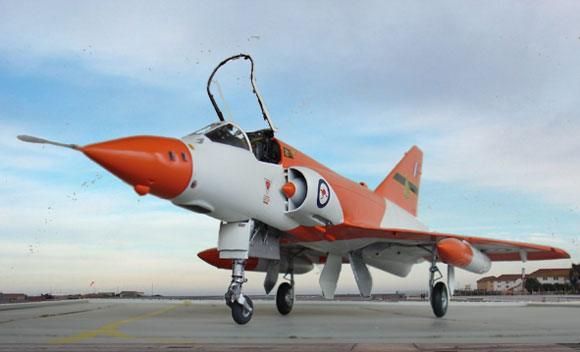
model "put onto" the tarmac....
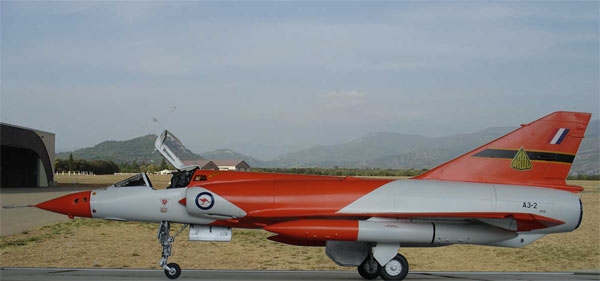

NOTE: a 1/32 Revell Mirage 5J kit was also used for a Kfir C7 conversion seen here...

(c) Copyright Meindert "designer"/ All rights reserved. Your comments are welcomed by webmaster
Created this page October 1, 2006
